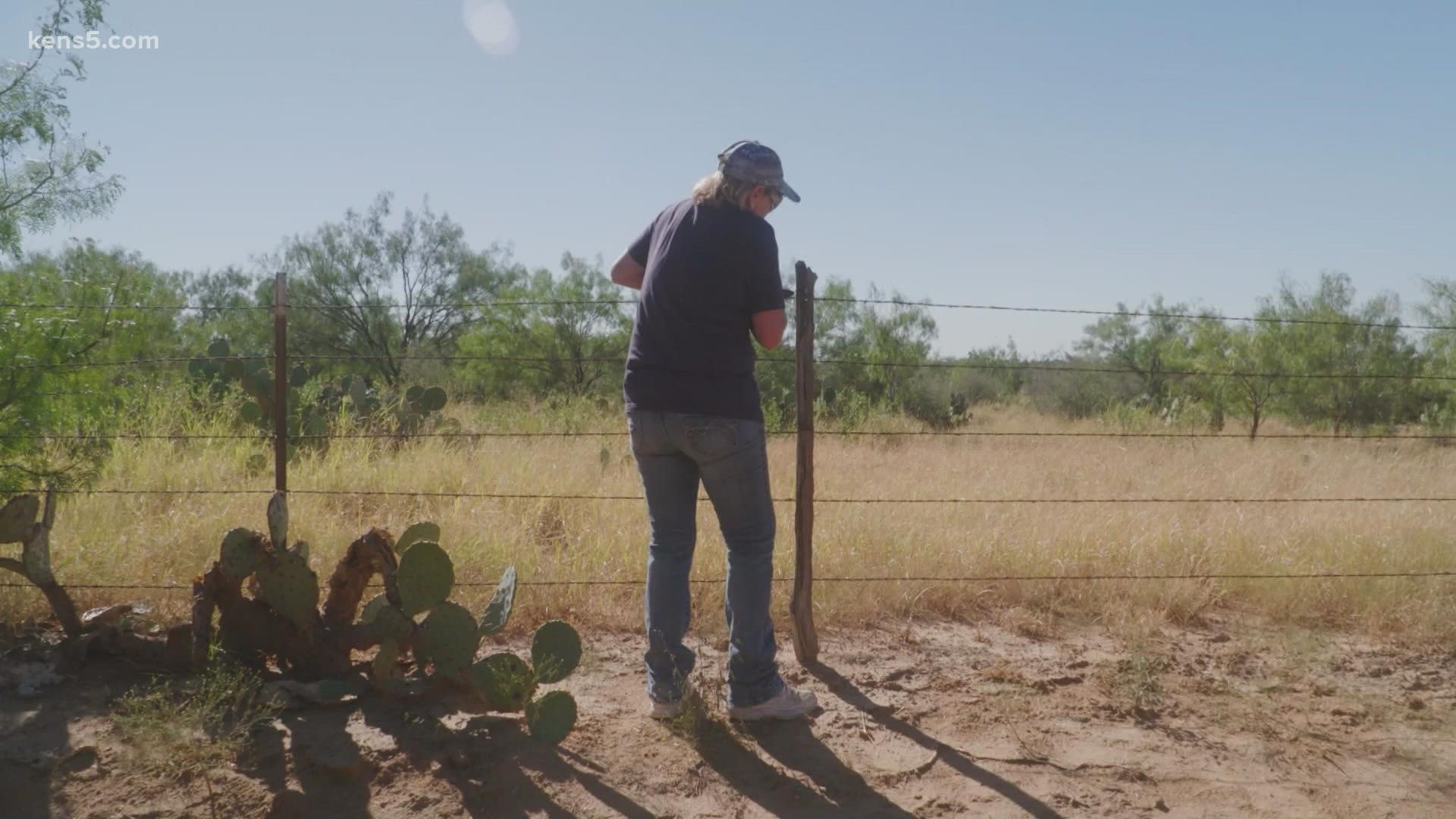DIMMIT COUNTY, Texas — As far as backyards go, Lynn’s property in Dimmit County is exactly what she wanted for her two kids.
“It's very quiet,” she said. “It's very peaceful out here.”
Lynn estimates she lives 18 to 24 miles from Mexico. The way she sees it, it’s not right on the border with Mexico; Lynn considers the actual border to be on or along the Rio Grande that separates the two countries.
“That 18 or 24 miles is nothing,” she told KENS 5. “Most people would consider, ‘Yeah, I probably do (live on the border).’”
“The trees dance when the wind blows, and the birds are always singing. There's this sense of just hearing God's country,” Lynn said. “And that's not a current environment that we experience. It's been diminished. It's been diminished greatly. We have photographs, we have events, we have damages that indicate that there are individuals out here (who) weren't invited.”
“We're being invaded,” she added. “Our property, our home, our backyard is being invaded by trespassers.”
'There's no resolution'
Lynn agreed to talk to KENS 5 about what life near the border is like if we didn’t use her last name or the real names of her kids. We’re also not showing images of them.
“Lots of people won't talk about this. They won't share what I'm putting out there and what I'm opening up about,” Lynn told KENS 5. “Just because they feel like they have previously and they don't get heard, and nothing changes. They're tired of trying to have a voice and seeing no results and no change. And it just continues; there's no resolution.”
Several years ago, moving to rural Dimmit County was very intentional for Lynn, a single mom with two kids who are now teenagers. They chose their pseudonyms: Emma and John.


Both teens have livestock. Both like what their version of a backyard has to offer, at least most of the time. Both get up when it’s still dark out and go take care of their animals before going to school.
“We do the livestock for a number of reasons,” Lynn said, “They provide life lessons that will stick with my children the whole rest of their life. They grow, and they learned from the companionship. It's a significant financial investment, between the horses and the cattle and the goats and these are all breeding animals.”
“My daughter's got huge ambitions,” Lynn added. “Her career path is going to be extensive, financially. She's building that now. She can't afford to lose some of these cattle or, heaven forbid, one of their horses. They're irreplaceable.”

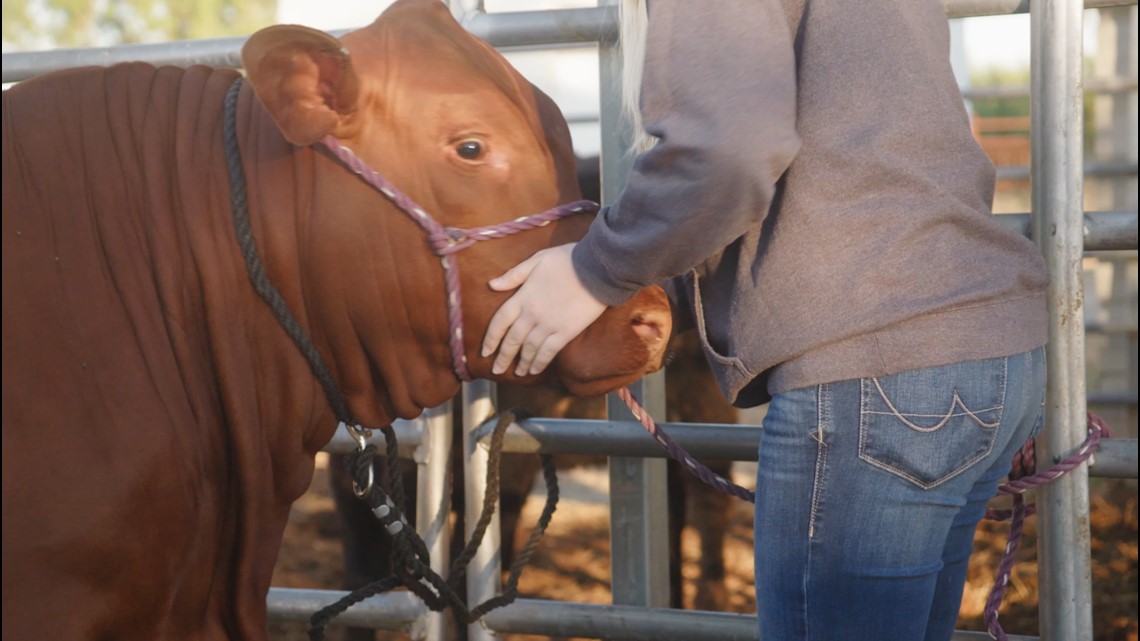
Life on this ranch is also providing Emma and John life lessons their mom wished they had to learn much later, if at all.
“With the immigrants, it has made it much more pertinent to have to know where each other's at and to make sure you take a dog with you," Lynn said. "That way, you have an added safety measure.”
The family told KENS 5 the teens try not to go outside alone. When they go to feed their livestock together, both have to make sure they know where the other person is.
“It can be scary at times, but I choose not to live scared, because I know what's out there is every day,” Emma said. “I've walked out to the barn in the morning and been confronted by one (migrant) with five other buddies hanging out in the brush, wanting water and a ride and out there by yourself, it can get a little scary, even with a dog.”
The teens told KENS 5 their lives on their property have changed with migrants coming through.
“It basically messes with our freedom,” Emma said. “My brother can't go to the tank on the other side of the fence and go fishing anymore, just because if he wants to we'd all have to go over there. Just so he could be around us (and) we can protect him.”
'Our backyard’s a lot bigger than most people's'
Lynn uses cameras to try to keep track of what happens on the property. She said she used to have nine of them, but most have been taken, destroyed, turned off or damaged.
“Clearly, somebody who doesn't want to be photographed, videoed or known to be someplace they don't belong,” she said of a camera near her horses and cattle she found turned off when KENS 5 was filming the story.
That same morning, KENS 5 watched as Lynn tried to find another camera she used to have on her property, to no avail. Lynn believed the camera had been taken, broken or disposed of somewhere she couldn’t find it.

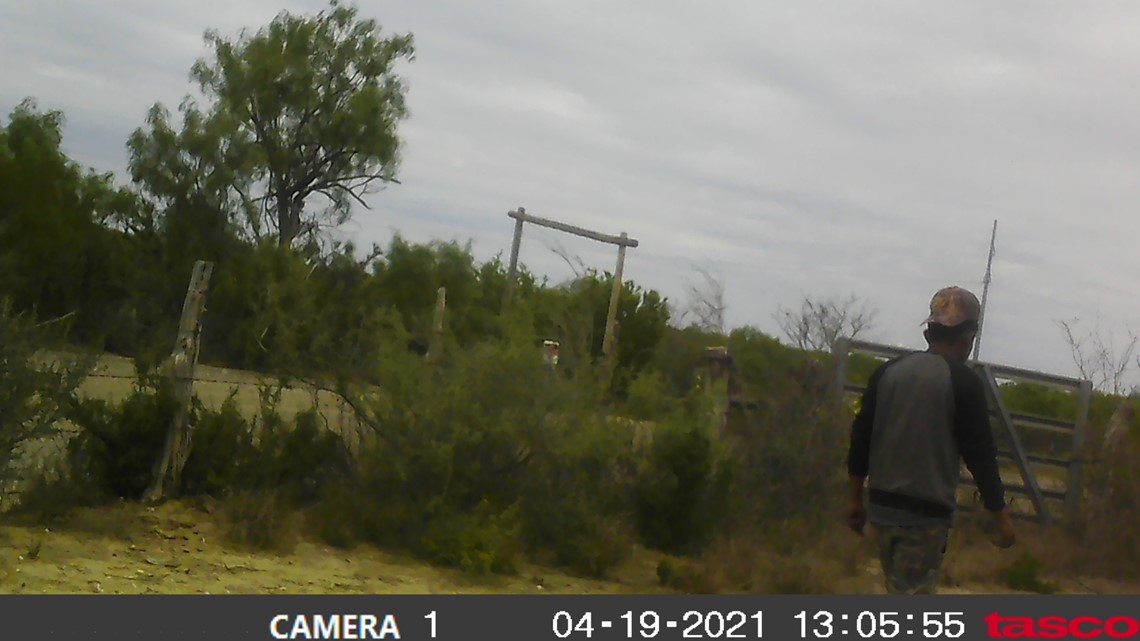
Lynn said she regularly checked the cameras she had left and downloaded hours of footage. Images Lynn shared with KENS 5 show people she identified as migrants coming through her property, loading up in trucks or being picked up by the U.S. Border Patrol.
It isn’t just surveillance footage that lets Lynn know people are coming through her property; she said she’s been approached in person.
“Sometimes it's fairly harmless and they're just looking for food or water, or, you know, they want help,” she said. “Other times, they're making demands. They want keys to vehicles, they want you to load them up and deliver them somewhere. They make demands and some are more forcible than others, and it's never comfortable to have that type of confrontation.”
“Imagine somebody just walking into your backyard and saying, ‘Hey, I'm gonna take your truck,’” Lynn added. “Because that's what happens. It's just our backyard’s a lot bigger than most people's.”
Lynn said she often finds gates to animal pens opened, or her kids’ animals are displaced or in the wrong places, which could mean injury or even death to livestock that can eat food that’s not meant for them.
“We've had multiple, multiple times where we've come out in the morning, or come home at night after dark, and there's animals in improper locations, or they're out,” Lynn said.
Every day she can, Lynn takes her golf cart and the dogs to check out the ranch, including gates, locks and fences.


“I kind of keep my head on a swivel,” she said. “I watch the ground for traffic markings, trash. Look around a lot of times, you'll find backpacks and leftover debris. Empty electrolyte bottles are usually a dime a dozen,” she said.
“We do this every day,” she said. “Try to. Every day is not feasible, certainly. But that’s the goal.”
Lynn pointed to multiple openings in barbed-wire fencing and showed KENS 5 what she does to fix them.
“This is a thoroughfare, this is where they're moved from one property to another,” she said. “In this circumstance, I will reset it, I'm going to use the wire that's on here, if it'll hold, and I will tighten it on the fence. I'm partly checking the fence lines that I know today I fix this. If tomorrow, when I come out and check fence lines it's moved again, I know I've had traffic and movements in here. It's really a strange feeling, to realize that there's eyes potentially out there watching you that you don't see. There's people around that you have no idea they're there. It's kind of creepy, kind of strange to think about. So tomorrow, we'll see if it's moved again.”
As much as fixing her fences has become second nature, so is counting livestock, checking to see whether they’re injured or hit.
“The majority of the time, the individuals that were in the vehicle (migrants picked up on her property) that fled are never located,” Lynn said. “There's no recourse. There's no satisfaction for having to go repair damage that was created by a third-party force. It's just go, fix it and hope it doesn't happen again. And it's time-consuming. It's not a process that happens quickly.”

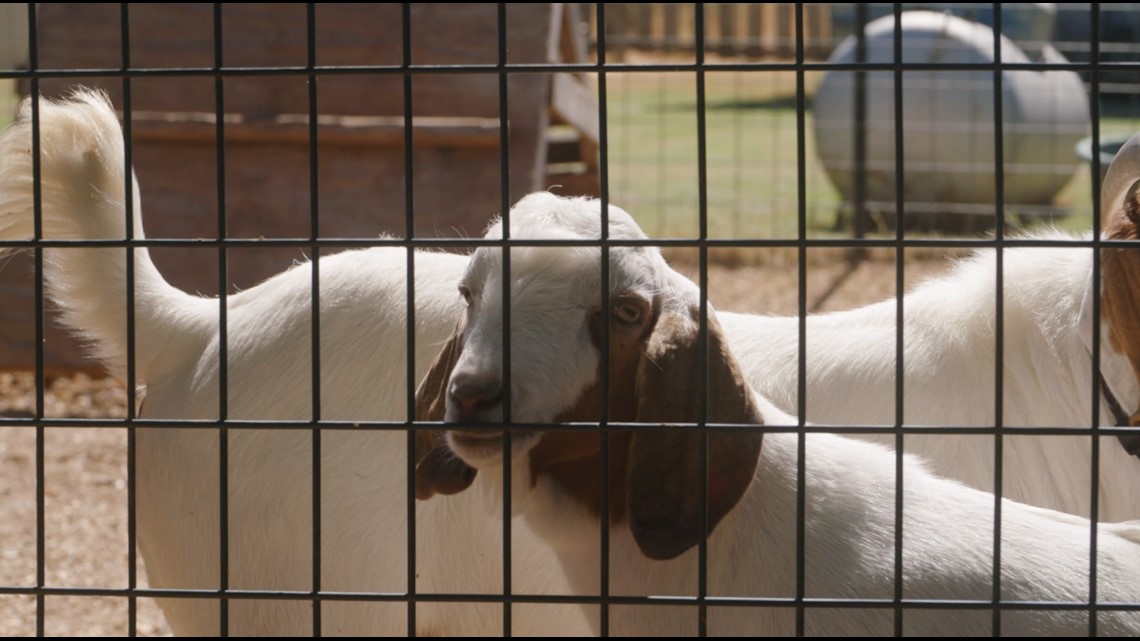
Lynn said she’s forced to always be in protection mode. She decided to quit her job, because she felt she had to be a constant presence for her children.
“It's a hard choice to make,” she said. “I'm a single mom. I don't have backup. But their safety and their security and their life is more important. So, we will struggle, I will forgo opportunities. I have to; I can't risk their lives.”
“It's real and it's happened more than once,” Lynn added about people approaching her and her children. “Daughter walked out into the breezeway by herself but had dogs with her. She was approached by one individual, and then there were five more that came up. This is a teenage girl.”
Lynn said nothing came of the encounter. But she isn’t dropping her guard.
“How do I judge the difference between an individual that approaches me that is looking just for a better life, versus an individual who's got harm intended? How do I judge that?” Lynn said. “That's where I come back to the whole blanket, regardless, either side of that equation that you don't belong here. Maybe that's harsh. But it's my reality. You never know when, how, who, what their intentions are. It's not like there's a consistent schedule. So yeah, it's being vigilant 24/7, and it's exhausting.”
'Definitely not a lifestyle that everybody’s built for'
The teenagers are tired too.
“I can't go across the road to check my herd of cattle,” Emma said. “I can't go feed them anymore. I can't even walk halfway up the driveway for fear of protection. It's just it messes with our freedoms, and most people don't understand.”
The kids say they don’t often talk about certain aspects of their ranch life at school or with friends.
“For the people that watch this, don't try to see it from your eyes. Try and see it from our eyes,” John said. “And try and put yourself in that situation.”
“A lot of people in this community like to be ignorant,” Emma added. “And when you're ignorant is when things happen, or you don't notice the whole spectrum around you. So, they just don't understand it. Part of it is that they all live in town. So, they don't understand being on a ranch for one. But two, they don't have to deal with it. And their parents kind of choose to ignore it. They limit their learning and what they know of it.”

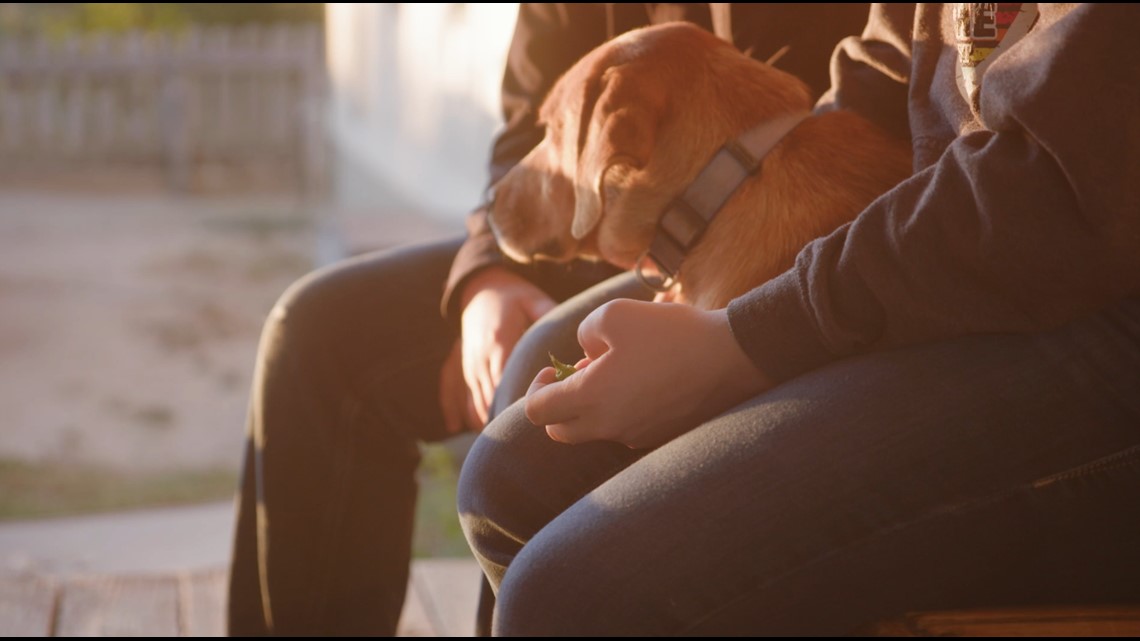
“They think, ‘Oh, well, you're just being racist,” John added. “They're just coming for a better life. And yes, some of them are. And I'm not being racist. I'm really not trying to or anything. I'm not racist. (I’m) a kid, right? And it’s just hard sometimes. So it's not something I want to talk about very much.”
Lynn said she’s noticed more people on her property in the last year. What happens in her backyard, Lynn believes, depends on who’s tens of thousands of miles away in the White House.
“Volumes kind of coincide with the demographic of the administration,” she said. “It has not slowed down under this administration. And the dynamic and the types of individuals we're seeing has changed drastically. We would see families and children and women coming through previously, and now it's strictly all males.”
Lynn said based on what she’s seeing, the previous administration was able to stem the traffic of migrants.
“What's in play right now? I don't see results. Not on my level. I'm not seeing a change,” she said.
Lynn said she didn’t have all the answers, but said people in charge aren’t coming up with any that work for her family.
“Not only do our borders need to be closed for a period of time until current conditions can be handled, and there's a plan in play,” Lynn said. “That plan probably incorporates a wall for border security of some sort. There's pros and cons to both. Other people who are not advocates of a wall are going to say, ‘well, you know, they're going to go under it, they're going to go over it.’ Absolutely, they are, you are not going to solve that mentality. However, it should slow it down. They're going to have to work harder at it. They're going to have to throw more resources at it.”
“The people who have the ability to fix it,” Lynn added, “I don't know if they don't really understand it. If they don't care if they have a different agenda. What I can identify is that it's out of control, it's unmanageable, and it's having far-reaching impacts. And I believe it's going to continue.”

